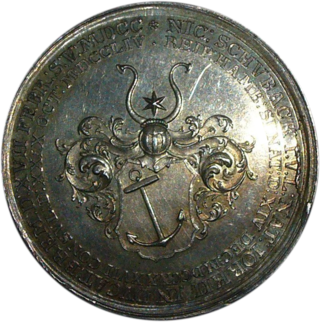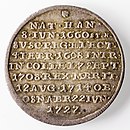
Groschen a name for various coins, especially a silver coin used in various states of the Holy Roman Empire and other parts of Europe. The word is borrowed from the late Latin description of a tornose, a grossus denarius Turnosus, in English the "thick denarius of Tours". Groschen was frequently abbreviated in old documents to gl, whereby the second letter was not an l, but an abbreviation symbol; later it was written as Gr or g.
The Silbergroschen was a coin used in Prussia and several other German Confederation states in northern Germany during the 19th century, worth one thirtieth of a Thaler.

The Bode Museum, formerly called the Kaiser-Friedrich-Museum, is a listed building on the Museum Island in the historic centre of Berlin. It was built from 1898 to 1904 by order of German Emperor William II according to plans by Ernst von Ihne in Baroque Revival style. The building's front square featured a memorial to German Emperor Frederick III, which was destroyed by the East German authorities. Currently, the Bode-Museum is home to the Skulpturensammlung, the Museum für Byzantinische Kunst and the Münzkabinett. As part of the Museum Island complex, the Bode-Museum was inscribed on the UNESCO World Heritage List in 1999 because of its outstanding architecture and testimony to the development of museums as a cultural phenomenon in the late 19th and early 20th centuries.

The Electorate of Saxony, also known as Electoral Saxony, was a territory of the Holy Roman Empire from 1356–1806. It was centered around the cities of Dresden, Leipzig and Chemnitz.

An Ephraimite was a debased coin part of whose silver content was replaced with copper. Ephraimites, as they came to be called, were issued under the authority of Frederick the Great of Prussia in the Duchy of Saxony and the Kingdom of Prussia from 1756 till 1763 during the Seven Years' War. The coins were spread by merchants and soldiers in Silesia, Bohemia, Poland and Courland and traded as if they were of official silver content. In return higher value foreign coins would be received, which could be used to pay the costs of army supply. By the end of 1762 Frederick the Great abandoned this policy. After the war the traditional content standards were restored.
The right of coinage in the Holy Roman Empire was one of the so-called regalia. It consisted of the right to issue regulations governing the production and use of coins. It covered the specification of currency, the right to mint and the right to use coins and the profit from minting. It is variously referred to in English sources as the "right of coinage", "coinage regality", "regality of coinage", "minting privileges" and "coinage prerogative".
The “Grumbach Feud”, in 1567, was a rather bizarre episode in the history of the Ernestine side of the House of Wettin, which led to life imprisonment for Elector John Frederick II “the Middle”, the Duke of Saxe-Coburg-Eisenach.
A Ganerbschaft, according to old German inheritance law, was a joint family estate, mainly land, over which the co-heirs (Ganerben) only had rights in common. In modern German legal parlance it corresponds to a "community of joint ownership".

Carl Ludwig Grotefend was a German epigraphist, philologist and numismat. He played a key role in the decipherment of the Indian Kharoshthi script on the coinage of the Indo-Greek kings, around the same time as James Prinsep, publishing Die unbekannte Schrift der Baktrischen Münzen in 1836. He was the son of the famous philologist Georg Friedrich Grotefend, who made the first successful attempts at deciphering Old Persian cuneiform.

The Tympf was a low-grade silver coin used in Poland-Lithuania, Brandenburg-Prussia, and Russia in the 17th and 18th centuries.

The history of Saxon coinage or Meissen-Saxon coinage comprises three major periods: the high medieval regional pfennig period, the late medieval pfennig period and the thaler period, which ended with the introduction of the mark in 1871/72. Rich silver deposits, which were discovered near Freiberg after the middle of the 12th century, helped Saxony to a leading position in German coinage.

A Schüsselpfennig, also Gehulchter Pfennig is so called due to the stamping technique which results in a concave, one-sided type of Pfennig coin. It was probably first minted in 1374 in the Palatinate. Small Schüsselpfennigs that had entered the Electorate of Saxony were referred to there as Näpfchenheller.

The Sachsenpfennig, sometimes called the Wendenpfennig or the Hochrandpfennig was a well-known coin of the pfennig type minted in the eastern part of the Stem Duchy of Saxony during the 10th and 11th centuries. It had an upturned perimeter and, next to the Otto Adelheid Pfennig was the most common pfennig type of its time. Sachsenpfennigs are the oldest coins minted in Saxony. Its different names represent a lack of clarity within mediaeval numismatics about the coin.
The Meissen gulden, abbreviation Mfl., was a Rhenish Gold Gulden that was established in Saxony in 1490 at a value of 21 groschen and which, from 1542 to 1838 became a coin of account of the same value.

Mintmaster marks are often the initials of the mintmaster of a mint or small symbols for example at the size of the letters on a coin inscription to denote the coins made under his direction. With his mark, the mintmaster assumed responsibility for ensuing the coins issued by his mint were in accordance with the regulations. Mintmaster marks were used as early as the time of bracteate coinage in the Holy Roman Empire, but these can only rarely be deciphered. All mintmaster marks since the beginning of the minting of Thalers have been identified.

The Roter Seufzer, also called the Seufzer and Leipziger Seufzer, was the popular name of the inferior six-pfennig coin minted in huge quantities in 1701 and 1702 by the Prince-Elector of Saxony and King of Poland, Augustus the Strong (1694–1733). The name of these coins was due to the loss that the population suffered as a result of the coins which had a high copper content.

The Guter Groschen, also Gutergroschen or Gutegroschen, abbreviation Ggr., is name of the groschen coin that was valued at 1⁄24 of a Reichsthaler from the end of the 16th century. It was called a "good groschen" to distinguish it from the lighter Mariengroschen, which was only valued at 1⁄36 Reichsthaler. The term Guter Groschen remained common until the middle of the 19th century.

The Bauerngroschen, also Burgroschen, was a groschen minted in the Free Imperial City of Goslar from 1477 until at least 1490 and continued to circulate until the 16th century. On the obverse it depicts a coat of arms with an imperial eagle beneath a helmet with a crown and on the reverse Saints, Simon and Jude. The two apostles were thought by the people to be farmers due to the poor quality stamping of the coins, hence the name, Bauerngroschen.

The Ewiger Pfennig or eternal penny was a coin of the regional pfennig period, which was minted until the late medieval groschen time. These coins are mostly of the Hohlpfennig or "hollow pfennig" type which, unlike bracteates, had to be exchanged regularly for a fee but were not subject to annual recall of coins in circulation, the Münzverruf.

A Bürgermeisterpfennig is a small silver coin that was issued in Hamburg after the death of a Mayor of Hamburg on the occasion of his funeral and which depicted the coat of arms as well as the biographical information and dates of office of the deceased mayor.
















